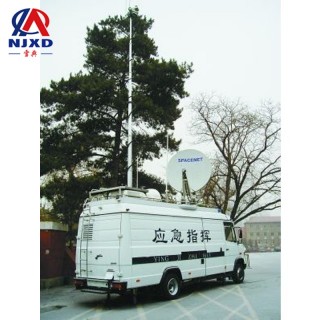NEWS
Basic Theory of data communication emergency lifting antenna
Time:2020-12-10 View:

Basic theory
Spectrum and bandwidth
The signal is the electromagnetic code of data, and the signal contains the data to be transmitted. The signal usually takes time as the independent variable, and a certain parameter (amplitude, frequency or phase) representing the message (or data) is the dependent variable. Signals can be divided into continuous signals and discrete signals according to whether the values of independent variable time are continuous. According to whether the values of dependent variables are continuous, signals can be divided into analog signals and digital signals.
The signal has two basic forms and characteristics: time domain and frequency domain. Time domain characteristics reflect the changes of signals over time. The frequency domain characteristics not only contain the same amount of information in the time domain of the signal, but also can clearly understand the spectrum distribution and occupied frequency span of the signal through the spectrum analysis of the signal. In order to obtain the requirements of the transmitted signal on the receiving equipment and channel, it is not enough to know only the time domain characteristics of the signal, but also the spectrum distribution of the signal. The time domain characteristic of the signal indicates the change of the signal with time. Since most of the energy in the signal is concentrated in a relatively narrow frequency band, we call the frequency band where most of the energy of the signal is concentrated as the effective bandwidth, which is called the bandwidth for short. Any signal has bandwidth. Generally speaking, the larger the bandwidth of the signal, the higher the data transmission rate using this signal, and the larger the bandwidth of the transmission medium is required.
Next, we will briefly introduce the spectrum and bandwidth of common signals. The spectrum of the sound signal is roughly in the range of 20 Hz to 2000 kHz (the signal below 20 Hz is infrasound, and the signal above 2000 kHz is ultrasonic), however, the reproduction of acceptable voice can be generated with a much narrower bandwidth, so the standard spectrum of voice signal is 300 Hz ~ 3400Hz, and its bandwidth is 3 kHz. The spectrum of TV signal is 0~4 MHz, so its bandwidth is 4 MHz. As a special example, the bandwidth of the monostable pulse signal is infinite. For binary signals, the bandwidth generally depends on the exact shape of the signal waveform and the order of 0 and 1. The greater the bandwidth of a signal, the more faithfully it represents a sequence of numbers.

Cut-off frequency and bandwidth
According to Fourier series, we know that if all frequency components of a signal can be transmitted to the receiver through the channel completely unchanged, then the signal formed by the superposition of these frequency components at the receiving end is exactly the same as the signal at the transmitting end, that is, the receiving end completely recovers the signal sent by the transmitting end. But in the real world, no channel can pass through all frequency components without loss. If all Fourier components are equally attenuated, the signal received by the receiver will be attenuated in amplitude, but there will be no distortion. However, all transmission channels and devices have different attenuation degrees for different frequency components. Some frequency components have almost no attenuation, while some frequency components are attenuated. That is to say, the channel also has certain amplitude frequency characteristics, which leads to distortion of the output signal. Generally, harmonics in the frequency range of 0 to fc Hz do not decay during channel transmission (or their attenuation is a very small constant), however, all harmonics above this fc frequency decay greatly during transmission, we decay the amplitude of a component of the signal during channel transmission to 0.707 (that is, the power of the output signal is reduced by half) the corresponding frequency is called the cut-off frequency of the channel. The cut-off frequency reflects the inherent physical characteristics of the transmission medium itself. In other cases, it is because people intentionally install filters in the line to limit the bandwidth used by each user, as shown in Fig. 2-4a. Sometimes, because a two-pass filter is added to the channel, the channel corresponds to two cut-off frequencies f1 and f2, which are respectively called the lower cut-off frequency and the upper cut-off frequency. The difference between these two cut-off frequencies f2-f1 is called the bandwidth of the channel. If the bandwidth of the input signal is less than that of the channel, all frequency components of the input signal can pass through the channel, so the output waveform obtained by the channel output terminal will be true. However, if the bandwidth of the input signal is greater than the bandwidth of the channel, some frequency components in the signal cannot pass through the channel, so the output signal will be somewhat different from the signal sent by the sender, distortion occurs. In order to ensure the correctness of data transmission, the bandwidth of the signal must be limited.
2.2.3 The maximum data transmission rate of the channel the binary number of bits that can be transmitted per unit time is called the data transmission rate. The increase of data transmission rate means that the time occupied by each bit decreases, that is, the cycle time of the binary digital pulse sequence will decrease, and of course the pulse width will also decrease. In the previous section, we already know that even if the binary digital pulse signal passes through an ideal channel with limited bandwidth, waveform distortion will occur, and when the bandwidth of the input signal is fixed, the smaller the bandwidth of the Channel, the greater the distortion of the output waveform. In other words, when the bandwidth of the channel is fixed, the greater the bandwidth of the input signal, the greater the distortion of the output signal, therefore, when the data transmission rate increases to a certain extent (the signal bandwidth increases to a certain extent), the signal receiver on the channel output cannot recover the transmitted digital sequence from the lost output signal at all. That is to say, even for ideal channels, the limited bandwidth limits the channel data transmission rate.
As early as 1924, H. Nyquist (Nyquist) realized the existence of this basic limitation and deduced the formula representing the maximum data transmission rate of the noise-free limited bandwidth channel. In 1948, C. Shannon further extended Nyquist's work to the situation where the channel was disturbed by Radom noise. Here, we briefly describe these classic results without proof. Nyquist proves that after any continuous signal f(t) passes through a channel with a noise-free bandwidth of B, its output signal is a time continuous signal g(t) with a bandwidth of B. If digital signals are to be output, g(t) must be sampled at equal intervals at a certain rate. It is meaningless that the sampling speed is higher than 2B times per second, because the high frequency component of the signal higher than channel bandwidth B has been attenuated by the channel. If g(t) consists of V discrete levels, that is, the possible result of each sampling is one of V discrete levels, the maximum data transmission rate Rmax of this channel is:
Rmax = 2Blog 2V (bit/s)
For example, a channel with a noise-free bandwidth of 3000 Hz cannot transmit binary digital signals with a rate exceeding 6000 bits/second. Before, we only consider the ideal channel without noise. For noisy channels, the situation will quickly deteriorate. The thermal Noise in the channel is measured by the Ratio of Signal power to Noise power, and the Ratio of Signal power to Noise power is called Signal-to-Noise Ratio. If we use S to represent the signal power and N to represent the noise power, the signal-to-noise ratio should be expressed as S/N. However, people usually do not use the absolute value of signal-to-noise ratio, but use 10 log10S/N to express it in decibel (dB). For a channel with S/N equal to 10, the signal-to-noise ratio is 1 0 d B; Similarly, if the S/N of the channel is equal to 100, the signal-to-noise ratio is 20 dB; and so on. Shannon's conclusion on the maximum data transmission rate of noisy channels is: for channels with bandwidth of BHz and signal-to-noise ratio of S/N, the maximum data transmission rate Rmax is:
Rmax = Blog2 (1 + S/N)(bit/S)
For example, for a channel with a bandwidth of 3 kHz and a signal-to-noise ratio of 30 dB, no matter how many quantization levels it uses or how fast the sampling speed is, the data transmission rate cannot exceed 30,000 bits/second. The conclusion of Shannon is derived from the information theory, and the scope of application is very wide. It is almost impossible to surpass this conclusion just like to invent perpetual motion machine. It is worth noting that Shannon's conclusion only gives a theoretical limit, but in fact, it is quite difficult to approach this limit.

Summary
A signal is an electromagnetic code of a message (or data), which contains the message to be transmitted. Signals can be divided into analog signals and digital signals according to whether the values of dependent variables are continuous. Correspondingly, communication can also be divided into analog communication and digital communication. Fourier has proved that any signal (whether analog signal or digital signal) is composed of harmonics of different frequencies, and any signal has corresponding bandwidth. Moreover, any channel will attenuate the signal when transmitting signals. Therefore, any channel has a data transmission rate limit when transmitting signals, this is the conclusion to be told by Nyquist theorem and Shannon theorem.
Transmission medium is the most basic component of computer network and communication, which occupies a large proportion in the cost of the whole computer network. In order to improve the utilization rate of transmission media, we can use multiplexing technology. Multiplexing technologies include frequency division multiplexing, wavelength division multiplexing and time division multiplexing, which are used in different occasions. Data exchange technologies include circuit switching, packet switching and packet switching, which have their own advantages and disadvantages. Modem is a device used to transmit binary data of a computer over an analog telephone network. The modulation methods of Modem include amplitude modulation, frequency modulation, phase modulation and orthogonal amplitude modulation, and Modem also supports data compression and error control.

CATEGORY
NEWS
- Communication system structure of lifting emergency data communication
- Basic Theory of data communication emergency lifting antenna
- Synchronization mode and characteristics of emergency lifting data communication
- Key technologies of mobile lifting data communication
- Application and development trend of data communication rise and fall communication